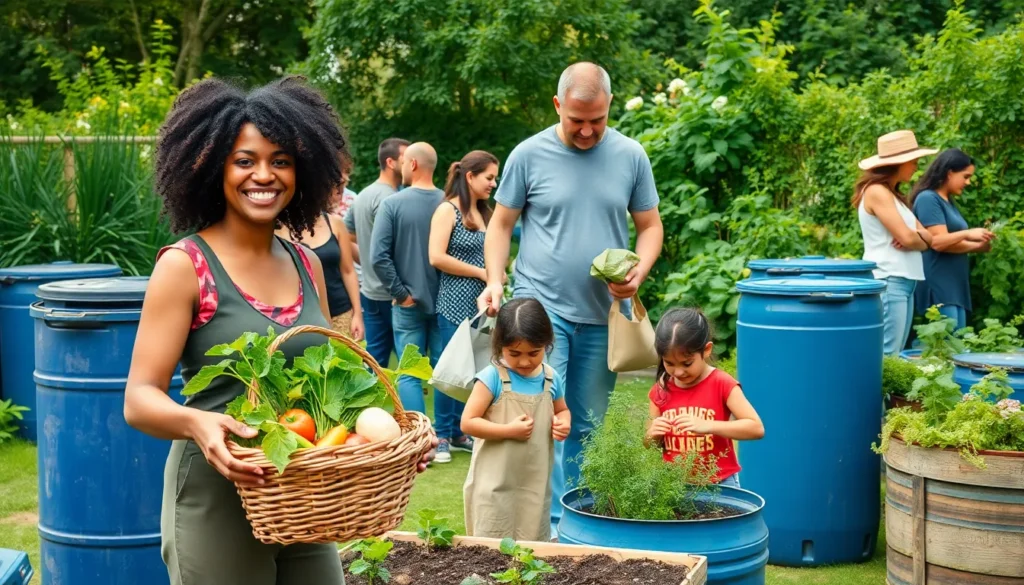Table of Contents
ToggleIn a world where plastic bags seem to multiply like rabbits and energy bills can make anyone cry, sustainable living might feel like a daunting task. But fear not! Embracing eco-friendly habits doesn’t have to mean giving up your beloved coffee or wearing hemp sandals. With just a few simple tweaks, anyone can turn their home into a green haven without sacrificing style or comfort.
Understanding Sustainable Living
Sustainable living involves making choices that reduce pollution and conserve natural resources, contributing to a healthier planet. Adopting sustainable practices improves daily life and supports future generations.
Definition of Sustainable Living
Sustainable living focuses on minimizing environmental impact through conscious lifestyle choices. It requires individuals to consider their energy consumption, waste production, and resource utilization. Embracing practices like reducing plastic usage and opting for renewable energy sources shapes a more sustainable future. Each small decision, such as purchasing local products or practicing energy conservation, plays a significant role in promoting ecological balance.
Importance of Sustainability
Sustainability is vital for preserving Earth’s ecosystems and wildlife. Protecting biodiversity ensures the survival of various species and their habitats. The growing climate crisis necessitates immediate action to reduce carbon footprints and combat global warming. Sustainable practices foster economic resilience, creating jobs in green industries. Moreover, they improve quality of life, promoting health through cleaner air and safer environments. Engaging in sustainability cultivates a sense of community, uniting individuals around a common goal for a better future.
Best Tips for Sustainable Living

Sustainable living is about making conscious choices that positively impact the environment. Here are actionable tips that anyone can implement for a more eco-friendly lifestyle.
Reduce, Reuse, Recycle
Reducing waste is the first step in sustainable living. It’s crucial to minimize consumption by choosing products with less packaging. Reusing items extends their lifespan and keeps them out of landfills; glass jars and cloth bags are excellent examples. Recycling materials like paper, plastic, and metals helps conserve resources and reduces energy use during production. Local recycling programs often accept various items. Separation of recyclables from regular trash maximizes recycling efficiency. Communities may offer drop-off centers for difficult-to-recycle materials. Every action contributes to a healthier planet.
Make Eco-Friendly Choices
Choosing eco-friendly products significantly reduces one’s environmental footprint. Opt for organic food; it often uses fewer chemicals and supports sustainable farming practices. Selecting energy-efficient appliances lowers energy consumption and reduces utility costs. Cloth napkins and reusable water bottles replace single-use options and minimize plastic waste. Sustainable fashion brands prioritize ethical production and often utilize recycled materials. Using biodegradable cleaning products helps prevent toxins from entering waterways. Each small choice adds up to a larger impact on sustainability goals.
Sustainable Practices at Home
Adopting sustainable practices at home enhances eco-friendliness while maintaining comfort. Small adjustments in daily routines significantly contribute to a healthier planet.
Energy Conservation
Prioritize energy conservation by switching to LED bulbs and using energy-efficient appliances. Consider adjusting thermostats to maintain optimal temperatures without excessive heating or cooling. Unplugging devices when not in use prevents phantom energy loss. Utilizing natural light during daytime hours also reduces reliance on artificial lighting. In addition, scheduling laundry and dishwashing during off-peak hours can save on electricity costs. Every effort in this area leads to decreased energy consumption and lower utility bills.
Water Usage
Reduce water usage by installing low-flow faucets and showerheads. Fixing leaks promptly prevents water waste and preserves precious resources. Collecting rainwater for gardening purposes can boost sustainability in landscaping. Furthermore, washing full loads of laundry and dishes conserves water as well. Opting for drought-resistant plants in gardens minimizes the need for irrigation. These mindful water practices contribute to overall sustainable living efforts.
Sustainable Transportation Options
Exploring sustainable transportation options helps reduce carbon footprints while promoting healthier lifestyles. Various methods contribute to efficient, eco-friendly commuting experiences.
Public Transit
Public transit systems significantly decrease the number of vehicles on the road. Buses, subways, and trains offer efficient means for many commuters, reducing greenhouse gas emissions per person. Many cities are expanding their public transport networks, making them more accessible. Multimodal transit options encourage people to shift from single-occupancy vehicles to shared transportation. Riders save money on fuel and parking fees while also contributing to cleaner air quality.
Biking and Walking
Biking and walking promote personal health along with environmental benefits. Both activities produce zero emissions while fostering community engagement. Cities that prioritize bike lanes and pedestrian paths make these modes more appealing. People can enjoy scenic routes, explore neighborhoods, and connect with nature. Cycling and walking reduce traffic congestion and promote a slower, more mindful pace of life. Integrating these options into daily routines supports sustainable living goals while offering enjoyable forms of exercise.
Supporting Sustainable Consumption
Supporting sustainable consumption includes making informed choices about products and shopping practices. Frequently choosing local and organic items promotes healthier ecosystems.
Local and Organic Products
Local and organic products benefit both consumers and the environment. Purchasing food from local farmers supports the local economy while reducing transportation emissions. Organic farming practices often involve fewer pesticides and synthetic fertilizers, which preserves soil health and biodiversity. Seasonal produce not only tastes better but also reduces carbon footprints associated with long-distance shipping. Prioritizing farmers’ markets and community-supported agriculture allows individuals to connect directly with producers, ensuring transparency in sourcing.
Conscious Shopping Habits
Conscious shopping habits encourage mindful spending to align with sustainability goals. Prioritizing quality over quantity leads to longer-lasting purchases that reduce waste. Choosing brands that prioritize ethical manufacturing and environmental responsibility ensures that spending contributes to positive change. Researching products before purchasing helps avoid items with excessive packaging or harmful materials. Using reusable bags and containers during shopping also minimizes plastic waste. Engaging in thoughtful shopping habits fosters a culture of sustainability, leading to better choices for the planet.
Embracing sustainable living is a journey that anyone can undertake. By making mindful choices and adopting small changes in daily routines, individuals can significantly reduce their environmental impact without sacrificing comfort or style. Each action taken contributes to a collective effort towards a healthier planet.
The shift towards sustainability fosters not just personal benefits but also strengthens community bonds. As more people engage in eco-friendly practices, the momentum for change grows, paving the way for a brighter future. Every effort counts and together, they create a ripple effect that can inspire others to join the movement. It’s time to take those steps towards a more sustainable lifestyle for the benefit of all.







